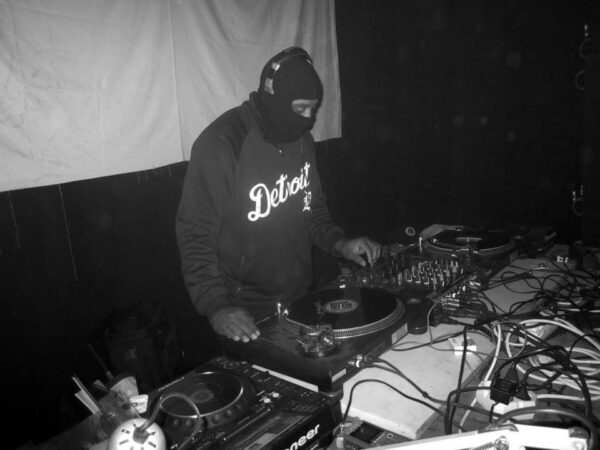zweikommasieben’s Guy Schwegler met Ingram in the summer of 2016 at Lucerne’s Klub Kegelbahn and witnessed his DJ set in Berghain at CTM Festival in 2017. After the first there was some small talk; after the second the conversation grew more substantial.
Guy Schwegler To what extent does the black balaclava still play a role in covering your identity? Does it still achieve its initial purpose of “not putting the ego upfront”?
Sherard Ingram I think at this point it has evolved into an aesthetic, simply because anonymity is virtually impossible for most people in today’s world. I hope it serves as a guide for younger artists and an inspiration for veterans. There are aspects of the balaclava presentation—which to my knowledge was started in the context of techno music by Detroit’s Underground Resistance—that people can utilize and draw from which I won’t detail here. However, it’s important to keep an eye out for those who use this aesthetic in a corny, disingenuous way.
GS Have the mask and other parts of your outfit[2] for shows become a bit of a brand or icon? Or maybe something iconographic? Wouldn’t it now make more sense to not wear the mask, from the perspective of “not putting the ego upfront”?
SI Maybe it has become a brand or an iconic look. But considering the absolutely soul-deflating and noxious icons, symbols, and brands in place now, maybe that’s a good thing. As far as not wearing the mask, I think it’s like asking an artist or performer to remove a component of their presentation to appease a formal logic.
GS To what extent are you interested in aesthetics of music? Are images, stories, themes, and other non-musical aspects connected to a certain artist and his or her work an important criterion for you?
SI I think when it is possible to use them and when they are inspiring, they are an important criterion. Today’s electronic artists and particularly those who are seeking to produce edgy and difficult-to-commercialize material concern themselves with being as multidimensional as possible. It’s relevant because we live in a multimedia era. So concepts, images, and themes are very important.
GS How much do you differentiate between techno and electro? Where do you see differences in their respective aesthetics?
SI Today I think the basic difference between the two involves the use of the 4/4 kick drum rhythm pattern pervasive in the majority of techno tracks versus it being almost non-existent in electro. Also, a lot of techno uses a Latin-style percussion loop and is as close to house music as you can get. I think electro goes for a grittier sound with heavy bass, and it’s more aggressive in terms of synthesizer patch selection at times. But with certain releases I hear a fusion of sorts, which I welcome.
GS In other interviews, you mentioned technology and technological developments and the related possibilities and dangers as an important inspiration and point of reference for your music[3]. Do you think these issues are more strongly related to electro’s aesthetics than to techno’s?
SI I haven’t really thought about that, to be honest. I think both forms have unlimited potential to highlight and raise issues in an intelligent and artistic way.
GS For me, electro and techno have two completely different “futuristic” concepts and ways of dealing with potential futures. Would you agree?
SI I’d agree that electro is generally more aggressive and techno more precise and clean, so to speak. From this generalization, certainly two branches or approaches to futuristic concepts and issues can be derived as well as fused. Or, to put it another way, techno is like Star Trek and electro is like Starship Troopers.
GS Would you ascribe electro’s current resurgence in the wider electronic music scene to its aesthetic relationship to the world?
SI I think people—particularly younger people—have simply discovered that there is more out there. There were and are so many DJs, producers, and artists that huddle around the 4/4 kick drum approach that I think it reached saturation. But don’t get me wrong—there are many great pieces within that approach. There are also other aspects beyond the kick pattern that were overused in techno and that allowed for people to recognize electro above the collective hum.
GS Given your travel schedule, your popularity in Europe, and the amounts of shows you play here, to what extent do you see yourself still as a part of the USA and of an American scene? Do you still call Detroit home?
SI I’m still a citizen of the USA, technically, and a product of working-class Detroit. I’m looking forward to doing what I can to make the American scene just as vibrant at the collective level as it is in the EU.
GS What, in your opinion, is lacking? Where do you see potential for improvement? Or maybe put completely differently: should it be improved or can we even talk about improvement and thereby use normative modes of understanding difference?
SI There are a dedicated few in the USA who have been working hard, spending money, time, sweat, and tears to establish a robust scene in their respective areas. It will take more work, dedication, savvy business models, fearless artists, and DJs, because in the USA you will have to compete against a massive commercial music following—and a subset of disingenuous opportunists.
GS Can electronic music in the USA still be a part of a civil rights movement (i.e., Black Lives Matter or others)? Could it ever or was it ever, in your opinion?
SI If electronic music becomes the soundtrack of a progressive social movement in the USA, it won’t be from any of the popular movements that you see today, the majority of which are not based in science and technology, in my view. I think the technological surge of the 21st century has set the stage for a new kind activism in which racism, economic growth for its own sake, and other ridiculous paradigms are totally dismantled by empirical evidence.
GS Could the failure to be part of a certain movement be connected to an aesthetic surrounding the music? And again, do you see differences there between techno and electro?
SI Most people who listen to techno and electro are probably detached from the mainstream anyway, and this would imply a detachment from popular movements. The day will come when our paradigms will be felt and heard without our having to attach ourselves to a particular group. What I mean is that ideally I would like to see something grown from techno’s, electro’s and/or the underground’s aesthetic. We don’t need to beg anyone to take us under their wing.
GS What could or should it be about, in your opinion?
SI Briefly: solving problems through science and technology with an emphasis on doing what is best for the human animal.
GS How much has the whole situation for electronic music (in the USA or in general) changed since Trump’s victory in the presidential election?
SI I really don’t know, but I’m hoping a new era is coming commensurate with the negative changes this administration will potentially bring in.
GS What newer musical influences do you try put to work in your own musical framework? Juke and footwork seem to become quite important to you (like in your recent DJ set at Klub Kegelbahn and also in the split EP with Galaxian[4]) or you also worked together with the experimental artist Russell Haswell [see zweikommasieben #17]…
SI I really like the grime aesthetic, black American-style trap, and, believe it or not, some really advanced techno. A lot of juke and footwork tracks are insane. And yes, I did a remix[5] for and an improvised show at Berghain with Russell Haswell.
GS Some of your work has already touched upon the experimental field[6]—is this something you’d like to expand on? And to what extent is your music already “experimental,” per se?
SI I will just say that I am interested in experimental music, which I define as using non-standard composition techniques, time signatures, scales, instruments, etc. The artist should be taking their piece to a place where a normal “musician” can’t or won’t go. My focus now is the dancefloor. This doesn’t mean I won’t expand, but I require some things to be in place first before I attempt experimental music. I respect the artists that have been doing it, and I don’t want to jump behind a synth and mash random keys with no rhythm track and proclaim myself as eclectic. I would be looking to make a serious contribution.
[1] See Drexciyans Among Us! by Anna Froelicher in zweikommasieben #14.
[2] Ingram often also wears a shirt with the “D” logo for Detroit’s baseball team.
[3] See the Wire magazine interview: https://www.thewire.co.uk/in-writing/interviews/dj-stingray-unedited (accessed 07.04.17).
[4] NU-1000, Shipwrec 2016
[5] “Gas Attack (DJ Stingray Atropine Mix),” Diagonal 2015
[6] Ingram has released on labels that can be considered as experimental, such as Wémé or Lorennzo Senni’s Presto!? [see zweikommasieben #18], and he also collaborated on experimental tracks with Gerald Donald under the NRSB-11 alias.
This interview originally appeared in zweikommasieben #15. Wit the upload to our website, we would like to highlight a black artist and his/her respective contribution to the music (and culture) we have been documenting with our magazine. Not least, us uploading this text is a reaction to the current protests happening all over the United States (and beyond) that are addressing issues of racism in police work and in our societies in general. Therefore, we would like to encourage you to donate to organisations and institutions directly or indirectly involved in these protests. While there are many ways to donate and/or help (see for example here), we would like to highlight the Southern Poverty Law Center: https://donate.splcenter.org/

